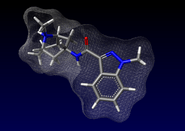Granisetron
 | |
 | |
| Clinical data | |
|---|---|
| Trade names | Kytril, Sancuso |
| AHFS/Drugs.com | Monograph |
| MedlinePlus | a601211 |
| Pregnancy category |
|
| Routes of administration | Oral, intravenous, transdermal |
| ATC code | A04AA02 (WHO) |
| Legal status | |
| Legal status | |
| Pharmacokinetic data | |
| Bioavailability | 60% |
| Protein binding | 65% |
| Metabolism | Hepatic |
| Biological half-life | 3–14 hours |
| Excretion | Renal 11–12%, faecal 38% |
| Identifiers | |
| |
| CAS Number |
109889-09-0 |
| PubChem (CID) | 3510 |
| IUPHAR/BPS |
2300 [3H]granisetron: 2292 |
| DrugBank |
DB00889 |
| ChemSpider |
10482033 |
| UNII |
WZG3J2MCOL |
| KEGG |
D04370 |
| ChEBI |
CHEBI:5537 |
| ChEMBL |
CHEMBL519643 |
| ECHA InfoCard | 100.212.327 |
| Chemical and physical data | |
| Formula | C18H24N4O |
| Molar mass | 312.41 g/mol |
| 3D model (Jmol) | Interactive image |
| |
| |
| | |
Granisetron is a serotonin 5-HT3 receptor antagonist used as an antiemetic to treat nausea and vomiting following chemotherapy. Its main effect is to reduce the activity of the vagus nerve, which is a nerve that activates the vomiting center in the medulla oblongata. It does not have much effect on vomiting due to motion sickness. This drug does not have any effect on dopamine receptors or muscarinic receptors.
Granisetron was developed by chemists working at the British drug company Beecham around 1988 and is available as a generic. It is produced by Roche Laboratories under the trade name Kytril. The drug was approved in the United Kingdom in 1991 and in United States in 1994 by the FDA.
A granisetron transdermal patch with the trade name Sancuso was approved by the US FDA on September 12, 2008.[1] Sancuso is manufactured by 3M Drug Delivery Systems Division in St. Paul, MN, for ProStrakan, Inc., a pharmaceutical company headquartered in Bedminster, NJ, with global headquarters in Scotland.
Granisetron is metabolized slowly by the liver, giving it a longer than average half-life. One dose usually lasts 4 to 9 hours and is usually administered once or twice daily. This drug is removed from the body by the liver and kidneys.
Medical uses
Chemotherapy
It may be used for chemotherapy-induced nausea and vomiting and appears to work about the same as ondansetron.[2] The most common side-effects of chemotherapy treatment are nausea, vomiting and diarrhea. This is one type of drug that a doctor can prescribe to prevent, lessen, or relieve discomfort.
Post operative
A number of medications including granisetron appear to be effective in controlling post-operative nausea and vomiting (PONV).[3] It is unclear if it is more or less effective than other agents such as droperidol, metoclopramide, ondansetron or cyclizine.[3]
Its efficacy has also been questioned with a research Dr. Yoshitaka Fujii having 12 published papers on this topic in Canadian Journal of Anesthesia retracted. A further five papers in the same journal on the same drug by Dr Fujii are considered indeterminate.
Other
- Is a possible therapy for nausea and vomiting due to acute or chronic medical illness or acute gastroenteritis
- Treatment of cyclic vomiting syndrome although there are no formal trials to confirm efficacy.
Adverse effects
Granisetron is a well-tolerated drug with few side effects. Headache, dizziness, and constipation are the most commonly reported side effects associated with its use. There have been no significant drug interactions reported with this drug's use. It is broken down by the liver's cytochrome P450 system and it has little effect on the metabolism of other drugs broken down by this system.
APF530
A New Drug Application (NDA) for APF530, a sustained-delivery form of Granisetron, was accepted in October 2012.[4] APF530 will be targeted as an antiemetic, towards patients undergoing radiation therapy and chemotherapy. APF530 contains the 5-HT3 antagonist, granisetron, formulated using the proprietary Biochronomer drug delivery system, which allows therapeutic drug levels to be maintained for five days with a single subcutaneous injection.
External links
See also
- 5-HT3 receptor antagonist: Drug discovery and development
- Zatosetron
- Bemesetron
- Tropanserin
- Ricasetron
- Tropisetron
References
- ↑ PRNewswire. FDA Approves Sancuso, the First and Only Patch for Preventing Nausea and Vomiting in Cancer Patients Undergoing Chemotherapy. September 12, 2008.
- ↑ Billio, A; Morello, E; Clarke, MJ (January 20, 2010). "Serotonin receptor antagonists for highly emetogenic chemotherapy in adults.". The Cochrane database of systematic reviews (1): CD006272. doi:10.1002/14651858.CD006272.pub2. PMID 20091591.
- 1 2 Carlisle, JB; Stevenson, CA (July 19, 2006). "Drugs for preventing postoperative nausea and vomiting.". The Cochrane database of systematic reviews (3): CD004125. doi:10.1002/14651858.CD004125.pub2. PMID 16856030.
- ↑ Drugs.com A.P. Pharma Announces PDUFA Action Date for APF530 New Drug Application Resubmission. October 16, 2012.
- Katzung, Bertram G. Basic and Clinical Pharmacology, 9th ed. (2004). ISBN 0-07-141092-9
- Aapro, M. (2004). "Granisetron: an update on its clinical use in the management of nausea and vomiting". The oncologist. 9 (6): 673–686. doi:10.1634/theoncologist.9-6-673. ISSN 1083-7159. PMID 15561811.